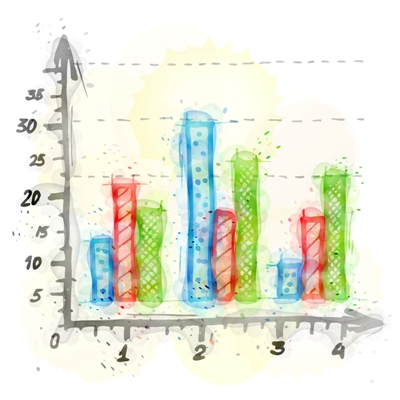Research shows that the human retina can transmit data to the brain about 60,000 times faster...
 “There is a magic in graphs. The profile of a curve reveals in a flash a whole situation — the life history of an epidemic, a panic, or an era of prosperity. The curve informs the mind, awakens the imagination, and convinces.”
“There is a magic in graphs. The profile of a curve reveals in a flash a whole situation — the life history of an epidemic, a panic, or an era of prosperity. The curve informs the mind, awakens the imagination, and convinces.”
― Henry D. Hubbard.
“The greatest value of a picture is when it forces us to notice what we never expected to see.”
– John Tukey.
Increasing Data and Reducing Attention Spans
Today’s world is characterized by information overload and attention deficit. The amount of data being created, processed, and hence available is exploding. More data was created in the last 2 years than was created since the beginning of humankind.
We wake up to see multiple notifications on our smartphones, we scroll through our Facebook and Instagram feeds through the day, we keep getting alerts from the various apps we have subscribed to and then of course there are the infinite emails we receive every day. There is no wonder that a consumer’s attention span is now less than before.
The Challenge
The combined effect of data explosion and reducing attention spans is that the window of opportunity one has to communicate a message with a stakeholder – be it a consumer, a business leader or even a friend is shorter. Especially when dealing with business leaders who sit through back-to-back meetings all day, it is vital to be able to get a message across in the most effective and efficient manner possible.
The impact on FP&A
As FP&A professionals, our job is to analyse financial, as well as, increasingly, non-financial data to identify the story hidden in the data, the “why” behind the numbers, and provide actionable insights to business leaders to influence better decision making.
The quantum of data available with FP&A teams is ever increasing and becoming more and more difficult to analyse using traditional tools and methods. The communication of the story or insights to top management or decision makers is even more challenging given that they are subjected to information overload leading to reduced attention spans.
Data visualization is a key enabler for FP&A teams in handling increasing volumes of data and effectively communicating insights to stakeholders.
What is Data Visualization?
Data visualization is the presentation of data using visual objects such as charts, pictures, graphs or maps. The goal of data visualization is to communicate a message more clearly and efficiently to the audience.
The concept of using pictorial representation to communicate important findings has existed for centuries. However, the advancement of technology has both increased the sheer quantum of data available but also delivered the capabilities to process and analyse the data.
FP&A and Data Visualization
While there is a good awareness of data visualization techniques and various software available from a number of service providers, it is vital for FP&A teams to keep the following in mind to truly harness the power of data visualization:
1. Prioritize simplification and be purposeful in analytics
FP&A teams deal with a large quantum of data regularly and it is easy to complicate a business problem as well as confuse the audience. In order to truly move towards data visualization techniques, an FP&A professional should make simplification in both his analysis as well as communication a top priority. Without this clear focus on simplification, one tends to stick to traditional means of analysis, in spite of voluminous data. Similarly, ensuring purposefulness in analytics will guide an FP&A professional towards visualization techniques since the purpose of any analytics is in its effective communication to influence decisions.
2. Understand the Stakeholder
Any message can be communicated effectively by understanding the target audience better. Whether to use data visualization methods and to what extent needs to be determined accordingly. For example, most CFOs would be comfortable with data in numeric form rather than visual. However, for stakeholders from non-finance functions, a graphical representation would be more comfortable and easier to understand. It is important to not project one’s own level of comfort with data or biases onto the recipient but instead understand his preferences to communicate a message better.
3. Understand the Content and Message
While data visualization is a collection of various visual objects, choosing the right one is critical. This requires a perfect understanding of the content and the message sought to be communicated. For example, a scatter plot would be suitable if the aim is to understand the distribution of data and identify outliers, a pie chart or stacked bar would be more suitable for analysing the composition of sales in a region, and an area chart would be perfect for showing part-to-whole relations like showing individual products’ contributions to the total sales for a year.
4. Leverage the power of colour
We know that the human brain is conditioned to respond to particular colours in a particular way. It is important to pick the right colours and colour scheme to drive home a message even more effectively. For example, a sequential colour scheme (e.g., shades ranging from white to pink to red) should be used to communicate a progression while a diverging colour scheme (e.g., red and blue) should be used to communicate a contrast.
5. Real-time Dashboards
Today, data visualization is no longer about static presentations. Business leaders are looking for real-time dashboards that get updated every minute and where scenario analysis can be easily performed. FP&A has a great role to play in enabling such dashboards. Partnering with IT teams, FP&A can take the initiative on building or further enabling such dashboards to deliver real-time analytics.
6. Do not mislead
The problem with data visualization vs data in a numeric form is that it can be used to mislead the audience if the entire picture is not revealed. This is a commonly applied technique by consultants or marketing teams to highlight only positives or paint a rosy picture. As FP&A professionals, we should be mindful of this and ensure we remain the conscience keepers of the organization. We must ensure data visualization does not end up misleading our stakeholders but in fact bring out the whole reality in the most effective manner.
In conclusion, FP&A teams cannot function effectively in today’s data-heavy and dynamic business landscape without data visualization. However, to truly harness its power, it is important to challenge the status quo, be purposeful, become more tech-savvy and grasp the nuances.
The article was first published in Unit 4 Prevero Blog
Subscribe to
FP&A Trends Digest

We will regularly update you on the latest trends and developments in FP&A. Take the opportunity to have articles written by finance thought leaders delivered directly to your inbox; watch compelling webinars; connect with like-minded professionals; and become a part of our global community.


